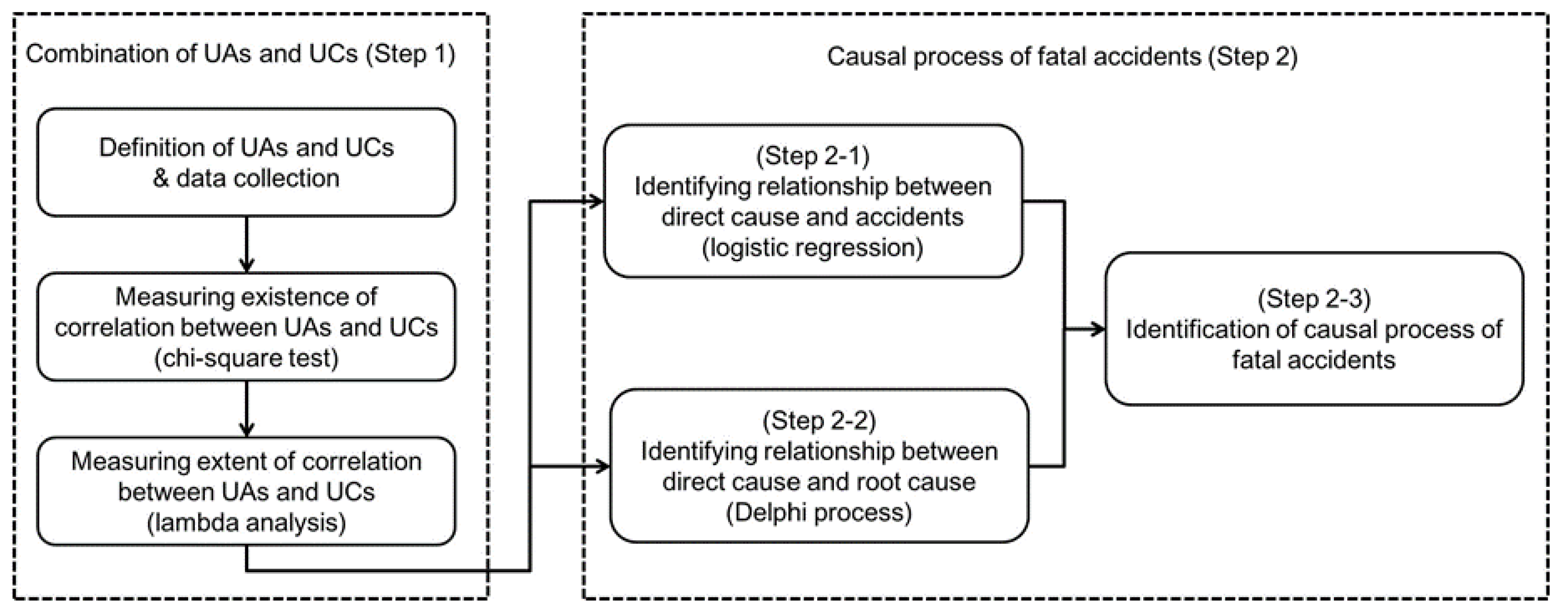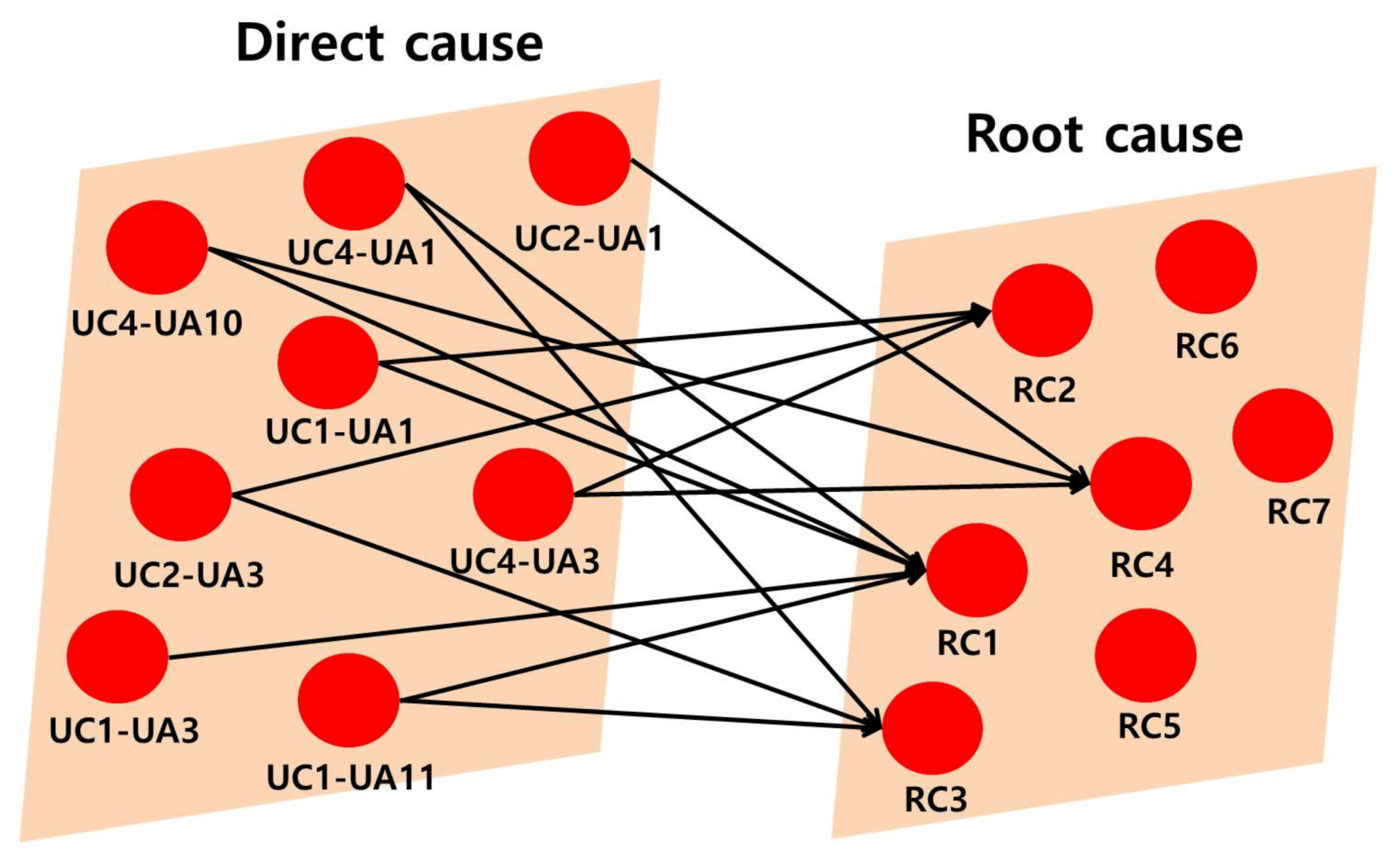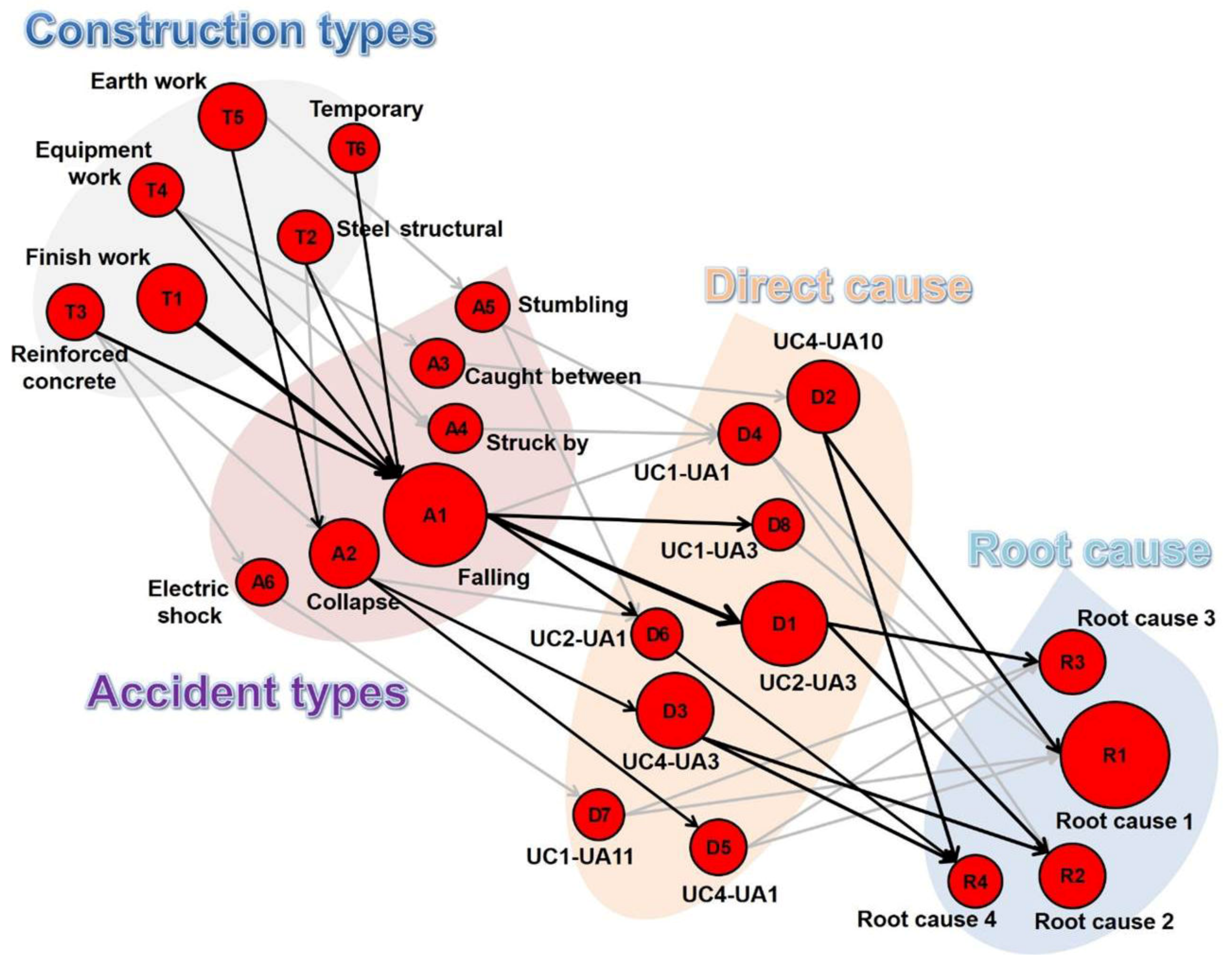5.1. Relationship between a Direct Cause and an Accident
Based on the findings in
Table 4, the authors identified a relationship between accidents and the direct cause. Major construction types and accident types caused by the eleven significant combinations were investigated in this study and then the relationships were analyzed in detail. In the case of Korea, the most common accident type among all accidents in the construction industry was falling, followed by collapse, being caught between items, stumbling, and electric shock, and the most common construction type during which accidents occur was finishing work, followed by reinforced concrete work, steel structural work, earth work, equipment work, and temporary work [
4].
In sequence, a logistic regression was conducted in this study, which is suitable in cases where the dependent variable is nominal, to determine a relationship between accidents and the direct cause. In a logistic regression model, the independent variable forms a linear relationship with the dependent variables after the log transformation.
A data set was established through the additional analysis for conducting the logistic regression. The dependent variable was “type of accident” (such as falling, collapse, being caught between items, stumbling, or electric shock) and the independent variables were UCs and UAs. For example, in the case of figuring out a relationship between falling and direct causes that are combinations of UCs and UAs, where falling might occur by UC 2 and UA 3, a dependent variable was defined as 1, and an independent variable was set as 2 and 3. Otherwise, if other types of accidents might happen by UC 4 and UA 10, the dependent variable was identified as 0, and an independent variable was set as 4 and 10.
Using the entire dataset, the logistic regression model was built in SPSS 19.0 to estimate the probability of falling accidents based on UCs and UAs, which are independent variables, and
Table 5 summarizes the results of the logistic regression. The result of logistic regression described how much influence combinations of UCs and UAs have on each type of accident, which can enable the investigation of a relationship between an accident and a direct cause.
Table 5 shows UC 1, UC 2, UA 1, UA 3, UA 4, and UA 9 had an influence on a falling accident at a 95% confidence level. UC 2 (a defect of a safety device) and UA 3 (incorrect use of protection), whose standardized coefficients (B) were 3.3 and 4.436, respectively, had the biggest effect on falling.
Using the results of logistic regression, Equation (1) estimates the conditional probability of falling caused by combinations between UC and UA on condition that both the UC and the UA occur [
22].
where
is the standardized coefficient of UC causing falling;
is the standardized coefficient of UA causing falling; and C is a constant of the equation.
Only the probability caused by the eleven combinations that were previously judged as having coherence between UA and UC were considered in this paper. As the result of logistic regression with falling and direct causes (
Table 5), the possible combinations of UCs and UAs meeting the confidence level were UC1‒UA1, UC1‒UA3, UC2‒UA1, and UC2‒UA3 among the 11 major combinations. The probability of falling caused by the combinations is presented in
Table 6. UC 2–UA 3 strongly influenced the probability of falling, which means fatal falling occurred frequently when workers misused protection in environments lacking safety equipment. This was followed by UC 1–UA 3, UC 2–UA 1, and UC 1–UA 1 as the main causes of falling. Similarly, the probability between other types of accidents and direct causes were calculated. The processes and results of these analyses (
Table 6) could indicate the relationship between the accidents and the combination of UCs and UAs, i.e., the direct causes.
5.2. Relationship between a Direct Cause and a Root Cause
It was also necessary to determine a relationship between the direct cause and the root cause to investigate the causality of construction accidents. There is very little numerical data on the relationship between root cause and direct cause, and the relationship is not simple [
23]. Therefore, the Delphi method was used in this paper because it requires much experience and know-how in safety management in order to analyze it. The Delphi method is an interactive process for proper decision-making that involves collecting the judgments of experts using a series of questionnaires intersected with feedback [
24]. The questionnaires are designed to focus on problems, solutions, or forecasts. Each subsequent questionnaire is developed based on the results of the previous questionnaire [
25]. It is a very flexible tool that permits the reaching of a consensus through successive stages of questionnaire and feedback.
A survey for the Delphi method was conducted thanks to blind-copy electronic mail, which was used to send the survey to experts in safety management in order to save time and expense for both the surveyor and the experts. The Delphi survey group size appears to be very different across the literature. However, it is often recommended to have a group of between 7 and 18 participants to draw some relevant conclusions and, at the same time, avoid difficulty in reaching consensus among the experts [
24]. Therefore, a Delphi method was used in this paper with seven safety managers who have more than 10 years of experience (see
Table 7).
Some studies identified the root causes of accidents as follows: a lack of proper training; safety equipment not provided; deficient enforcement of safety measures; unsafe equipment, method, or conditions; poor attitude to safety; and isolated deviation from prescribed behavior [
26,
27]. However, the existing root causes needed to be modified to suit the situation in the Korean construction industry, as the root causes can generally vary depending on the social atmosphere and the environment. Therefore, the major root causes that cause fundamental problems in the construction industry were deduced in this paper using a primary open-ended question.
The results are presented in
Table 8, which presents seven major root causes of accidents in the Korean construction industry.
In this paper, the statistical analysis of round 1 and round 2 correspond to the results expressed in the discussion paragraph. It must be noted that the results of round 1 and round 2 were the same because the synthesis and proposition that was done after round 1 satisfied all of the experts. As a consequence no change was made between the answers of round 1 and round 2. An overall relationship between direct causes and root causes was determined by using closed-ended questions (round 1). In this step, experts were asked to identify major accident cases caused by the eleven combinations defined earlier. Then, the authors selected the root causes that were judged the cause of each combination. This made it possible to investigate the potential relationship between a direct cause and a root cause. Finally, another closed-ended question (round 2) was asked in order to confirm the identified relationships from the experts. Prior to asking the last question, the results of their answers for the previous question were shared and discussed with the experts in order to reach a consensus between the experts. The overall results are relevant as the interrogation of seven experts makes them trustworthy.
The relationships between direct causes and root causes derived from the questions were shown in
Figure 2. According to
Figure 1, the experts judged the most consequential root cause to be root cause 1, influencing several combinations made up of UCs and UAs, followed by root causes 2, 3, and 4. However, they did not judge the other root causes as producing an effect on the direct causes. The researcher found it was especially unexpected that root cause 5 was excluded from the results. When interpreting the results of the relationship between root causes and direct causes, accidents would occur by direct causes, such as the defect of a safety device (UC 2), the approach to a dangerous place (UA 1), a dangerous place (UC 4), and the wrong use of protection (UA 3), if the construction period is insufficient.
5.3. Identification of Causal Process of Fatal Accidents
A connection between accidents and a direct cause was determine din this paper using a chi-square test and logistic regression, and then a relationship between a direct cause and a root cause was determined using the Delphi method. In this section, the investigation and analysis of the causal process of fatal accidents in the construction industry is described. It is practicable to investigate the causal process by arranging the two relationships studied earlier based on direct cause.
In the results depicted in
Figure 3, the size of the circle represents the degree of danger at each step, and the thickness of the arrow indicates the degree of connection between the circles. From
Figure 3, it is possible to recognize that the process of accident occurrence is significantly complex, which means that it is extremely difficult to determine proper root causes by simply analyzing accident cases without also investigating the causal process to prevent accidents in the construction industry.
According to the causal process established in this study, the primary root cause leading to fundamental problems was root cause 1 (lack of manger’s safety consciousness), followed by root cause 4 (insufficient construction period), and root cause 3 (lack of education about safety). These results were in line with previous studies such as Toole et al.’s [
24] selection of “lack of proper training” and “poor attitude toward safety” or Choudhry et al.’s [
26] findings of “perceived risk” and “safety orientation and training” as the main root causes. In addition, the results of this study show that the combination of UC2‒UA3 and root cause 1 was the most influential. The combination UC2‒UA3 caused by root cause 3 affected falling significantly, and UC4‒UA3 caused by root cause 4 had the most influence on collapse.
It is necessary to consider root causes by construction types because each root cause has a different influence in different construction scenarios. Therefore, the researcher examined major root causes in the context of different construction types.
Temporary work: Because most subcontracting groups hired for temporary work are usually smaller and more financially insecure than other subcontracting groups, they often do not have the wherewithal to educate their workers about safety. This makes managing temporary workers more difficult, and their lack of education about safety is a major root cause of temporary work.
Earth work: Most earth work is conducted in uncertain environments, which leads to numerous changes of plans. When managers control these changes, they usually consider schedules or cost to be the highest priority, which can cause serious problems. Thus, the lack of a manager’s safety consciousness is judged as a major root cause in earth-work accidents.
Frame work, concrete work, and steel work: According to safety experts, the safety education level of workers in frame work, as well as reinforced-concrete work and steel structural work, is commonly poor because these types have the highest percentage of day workers and foreign workers among all construction types. Lack of familiarity with an ever-changing crew as well as language barriers and communication issues may be the basis for why the lack of education about safety is considered to be a major root cause.
Finishing work: Many projects are commonly conducted with insufficient budgets and completion schedules because of an overheated bid market, which greatly influences finishing work, which is postproduction. Thus, as workers of finishing work are often pressed for time, they make mistakes or take unsafe actions in the middle of their work. For this reason, rushing to complete a job on schedule is considered a root cause of accidents in finishing work.
Equipment work: Finally, equipment work is widely recognized as a comparatively safe construction type. Ironically, as workers in equipment work are more educated about their work and have sufficient knowledge of it, their expertise occasionally causes managers to be insensitive to safety and negligently supervise their workers. Therefore, the lack of a manager’s safety consciousness is judged as a major root cause of equipment work. In addition, the ratio of accidents caused by the 11 major combinations has not decreased significantly since 2007 (see
Table 9). Especially an observation of the trend of accidents by each combination reveals that the ratio of accidents caused by some combinations, such as UC 4–UA 3, UC 1–UA 11, and UC 1–UA 3, has a rising trend, as shown in
Table 9.











